| Bariatric glossary |
Click a word on the left and the definition will appear here:
|
Click a word on the left and the definition will appear here:
Adipose tissue: Fat tissue in the body.

Click a word on the left and the definition will appear here:
Arthritis: Inflammation and degeneration of the joints.
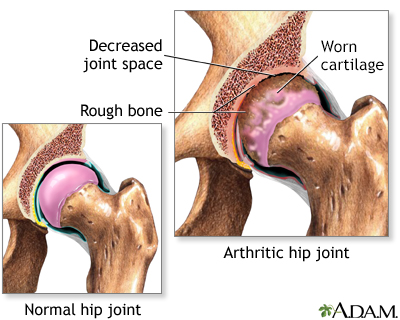
Click a word on the left and the definition will appear here:
Bariatric: An area of medicine that deals with the study and treatment of obesity.
Click a word on the left and the definition will appear here:
Bariatric surgery: Surgery that is performed in order to help an individual lose weight. Also called weight loss, anti-obesity, or obesity surgery.
Click a word on the left and the definition will appear here:
Bioelectrical impedance analysis (BIA): A way to estimate the amount of body weight that is fat and nonfat. Nonfat weight comes from bone, muscle, body water, organs, and other body tissues. BIA works by measuring how difficult it is for a harmless electrical current to move through the body. The more fat a person has, the harder it is for electricity to flow through the body. The less fat a person has, the easier it is for electricity to flow through the body. By measuring the flow of electricity, one can estimate body fat percent.
Click a word on the left and the definition will appear here:
Body mass index (BMI): A formula (weight in kg divided by height in m squared) which is used to evaluate whether an individual's weight is in the underweight, normal, overweight, obese, or morbidly obese range.
Click a word on the left and the definition will appear here:
Calorie: A unit of energy in food. Foods have carbohydrates, proteins, and fats. Some beverages have alcohol. Carbohydrates have 4 calories per gram. Proteins have 4 calories per gram. Alcohol has 7 calories per gram. Fat has 9 calories per gram.
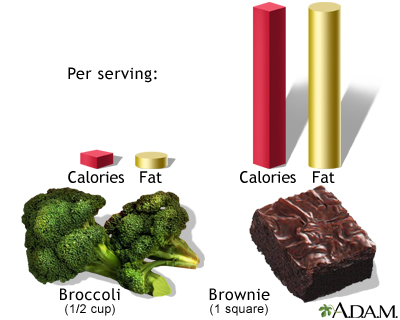
Click a word on the left and the definition will appear here:
Carbohydrate: A major source of energy in the diet. There are two kinds of carbohydrates -- simple carbohydrates and complex carbohydrates. Simple carbohydrates are sugars and complex carbohydrates include both starches and fiber. Carbohydrates have 4 calories per gram. They are found naturally in foods such as breads, cereals, fruits, vegetables, and milk and dairy products. Foods such as sugar cereals, soft drinks, fruit drinks, fruit punch, lemonade, cakes, cookies, pies, ice cream, and candy are very rich in sugars.
Click a word on the left and the definition will appear here:
Cholesterol: A waxy, fatty substance found in tissues throughout the body. Certain types of cholesterol circulating in the bloodstream can accumulate in blood vessels, blocking normal blood flow, and leading to heart attack and other circulatory complications.

Click a word on the left and the definition will appear here:
Diet: What a person eats and drinks. Any type of eating plan.
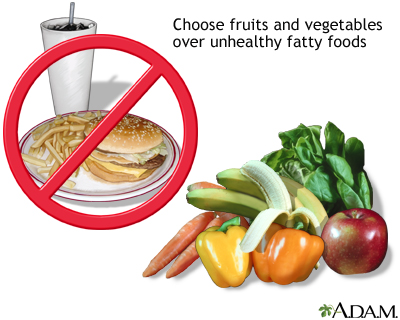
Click a word on the left and the definition will appear here:
Dumping syndrome: A condition that occurs after gastric bypass surgery, when food travels too quickly from the stomach to the intestine. This can cause a drop in blood pressure, abdominal cramping, diarrhea, sweating, and dizziness.
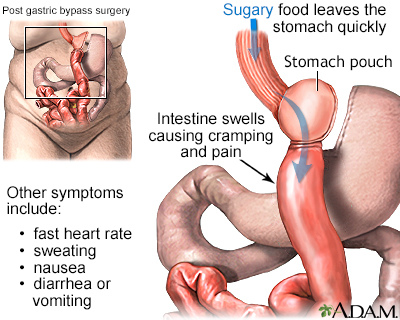
Click a word on the left and the definition will appear here:
Energy expenditure: The amount of energy, measured in calories, that a person uses. Calories are used by people to breath, circulate blood, digest food, and be physically active.
Click a word on the left and the definition will appear here:
Fat: A major source of energy in the diet. All food fats have 9 calories per gram. Fat helps the body absorb fat-soluble vitamins, such as vitamins A, D, E, and K, and carotenoids. Some kinds of fats, especially saturated fats, may cause blood cholesterol to increase and increase the risk for heart disease. Other fats, such as unsaturated fats do not increase blood cholesterol. Fats that are in foods are combinations of monounsaturated, polyunsaturated, and saturated fatty acids.
Click a word on the left and the definition will appear here:
Gastric bypass surgery: A type of weight loss or bariatric surgery in which the stomach is made smaller and the gastrointestinal tract is altered so that food "bypasses" the rest of the stomach and certain parts of the intestine. The procedure results in decreased stomach capacity and interference with the absorption of calories, allowing weight loss to occur.

Click a word on the left and the definition will appear here:
Gastroplasty: Surgery to reshape the stomach.
Click a word on the left and the definition will appear here:
HDL: See high-density lipoprotein.
Click a word on the left and the definition will appear here:
Healthy weight: Compared to overweight or obese, a body weight that is less likely to be linked with any weight-related health problems such as type 2 diabetes, heart disease, high blood pressure, high blood cholesterol, or others. A body mass index (BMI) of 18.5 up to 25 refers to a healthy weight, though not all individuals with a BMI in this range may be at a healthy level of body fat. They may, instead, have more body fat tissue and less muscle. A BMI of 25 - 30 refers to overweight, and a BMI of 30 or higher refers to obese.
Click a word on the left and the definition will appear here:
High blood pressure: Another word for "hypertension." Blood pressure rises and falls throughout the day. An optimal blood pressure is less than 120/80 mmHg. When blood pressure stays high, greater than or equal to 130/85 mmHg, it is considered high blood pressure. High blood pressure increases the risk for heart disease and stroke.

Click a word on the left and the definition will appear here:
High-density lipoprotein (HDL): A form of cholesterol that circulates in the blood. Commonly called "good" cholesterol. High HDL lowers the risk of heart disease. An HDL of 60 mg/dl or greater is considered high and is protective against heart disease. An HDL of less than 40 mg/dl is considered low and increases the risk for developing heart disease.

Click a word on the left and the definition will appear here:
Hydrogenation: A chemical way to turn liquid fat (oil) into solid fat. This process creates a new fat called trans-fatty acids. Trans-fatty acids are found in margarine, shortening, and some commercial baked foods like cookies, crackers, muffins, and cereals. Eating a large amount of trans-fatty acids may raise heart disease risk.
Click a word on the left and the definition will appear here:
Kcal: The abbreviation for "Kilocalories," a unit of energy. This is equivalent to the unit of energy known as a Calorie (which is generally not capitalized in common usage).
Click a word on the left and the definition will appear here:
Laparoscope: A narrow tube with an attached fiberoptic camera that can be slipped into the abdomen through a tiny "keyhole" incision, allowing the abdominal contents to be viewed without a traditional open incision.
Click a word on the left and the definition will appear here:
Laparoscopic adjustable band system: A surgical procedure in which an inflatable band is placed via laparoscopy around an area of the stomach. Saline can be injected into or removed from the band after surgery in order to adjust the size of the stomach pouch and the emptying of food into the rest of the stomach.
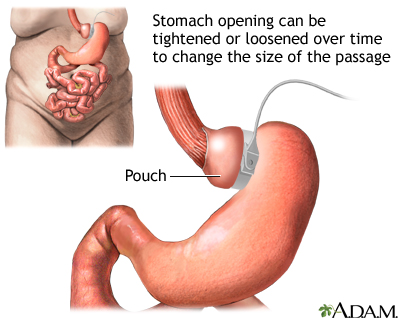
Click a word on the left and the definition will appear here:
Laparoscopic surgery: Surgery that avoids a traditional, large, open surgical incision, instead using multiple buttonhole-sized incisions. A fiberoptic scope inserted in one of these incisions allows viewing of the abdominal contents, and miniature surgical instruments inserted into the other incisions allow specific surgical procedures to be accomplished.

Click a word on the left and the definition will appear here:
LDL: See low-density lipoprotein.
Click a word on the left and the definition will appear here:
Lipoprotein: Compounds of protein that carry fats and fat-like substances, such as cholesterol, in the blood.
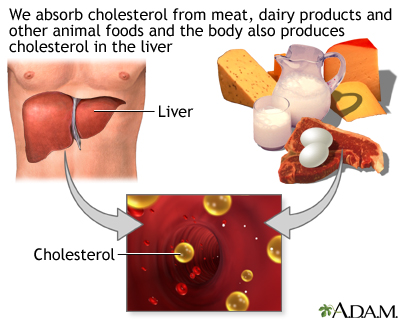
Click a word on the left and the definition will appear here:
Low-density lipoprotein (LDL): A form of cholesterol that circulates in the blood. Commonly called "bad" cholesterol. High LDL increases the risk of heart disease. Your LDL should be below 100 mg/dL. An LDL of less than 110 mg/dl is considered acceptable, 110-129 mg/dl is considered borderline, and 130 mg/dL or above is high. If you already have heart disease plus another strong risk factor for heart problems -- such as obesity, diabetes, current cigarette smoking, poorly controlled high blood pressure, or the metabolic syndrome (high triglycerides, low HDL cholesterol, and obesity) -- you should bring your LDL cholesterol below 70 mg/dL.

Click a word on the left and the definition will appear here:
Malabsorptive: Refers to procedures designed to interfere with the absorption of calories through the intestine.
Click a word on the left and the definition will appear here:
Metabolism: All of the processes that occur in the body that turn the food you eat into energy your body can use.
Click a word on the left and the definition will appear here:
Monounsaturated fat: Fats in foods are combinations of monounsaturated, polyunsaturated, and saturated fatty acids. Monounsaturated fat is found in canola oil, olives and olive oil, nuts, seeds, and avocados. Eating food that has more monounsaturated fat instead of saturated fat may help lower cholesterol and reduce heart disease risk. However, it has the same number of calories as other types of fat, and may still contribute to weight gain if eaten in excess.
Click a word on the left and the definition will appear here:
Morbid obesity: A condition in which an individual is severely obese (BMI is over 40), 100 pounds or more overweight.
Click a word on the left and the definition will appear here:
Obese: A condition in which your weight is much more than it should be for your height (BMI over 30), and in which the percentage of body fat is also considerably in excess. Waist size may be even more important than BMI. For most women, obesity-related health dangers increase at a waist size of 35 - 37 inches and above. For most men, obesity health dangers increase at 40 inches and above.

Click a word on the left and the definition will appear here:
Obstructive sleep apnea: Collapse of the upper airway structures during sleep, resulting in disruption of breathing of 10 seconds or longer occurring periodically throughout sleep. May occur hundreds of times throughout the night.
Click a word on the left and the definition will appear here:
Overweight: A condition in which an individual's weight exceeds that expected for his or her height (BMI 25-29.9), and in which the percentage of body fat is also in excess. Waist size may be even more important than BMI (see Obese).
Click a word on the left and the definition will appear here:
Percent body fat: A measurement of how much of your body weight is due to fat versus muscle and other tissues. Percent body fat can be a good indicator of how overweight you are and the potential impact of your weight on your health. However, there is no easy way to measure this at home. For most purposes, other methods like body mass index, waist circumference, and waist-to-hip ratio are sufficient for determining whether you are overweight. Percent body fat can be determined with calipers that measure a fold of skin, water displacement (underwater weighing), or bioelectrical impedance analysis (BIA).
Click a word on the left and the definition will appear here:
Physical activity: Any form of exercise or movement. Physical activity may include planned activity such as walking, running, basketball, or other sports. Physical activity may also include other daily activities such as household chores, yard work, walking the dog, etc.

Click a word on the left and the definition will appear here:
Polyunsaturated fat: A highly unsaturated fat that is liquid at room temperature. Fats that are in foods are combinations of monounsaturated, polyunsaturated, and saturated fatty acids. Polyunsaturated fats are found in greatest amounts in corn, soybean, and safflower oils, and many types of nuts. They have the same number of calories as other types of fat, and may still contribute to weight gain if eaten in excess.
Click a word on the left and the definition will appear here:
Premature death: Death that occurs at a younger age than would be expected according to known statistics.
Click a word on the left and the definition will appear here:
Protein: One of the three nutrients that provides calories to the body. Protein is an essential nutrient that helps build many parts of the body, including muscle, bone, skin, and blood. Protein provides 4 calories per gram and is found in foods like meat, fish, poultry, eggs, dairy products, beans, nuts, and tofu.
Click a word on the left and the definition will appear here:
Registered Dietitian (R.D.): A health professional who is a food and nutrition expert. A person who has studied diet and nutrition at an American Dietetic Association (ADA) approved college program and passed an exam to become a registered dietitian.
Click a word on the left and the definition will appear here:
Restrictive: Refers to procedures designed to decrease the amount of food that the stomach can hold.
Click a word on the left and the definition will appear here:
Roux-en-Y gastric bypass: A specific type of gastric bypass surgery in which the stomach is made smaller and the flow of food from the stomach into the intestine is altered in a way that interferes with the normal absorption of calories.

Click a word on the left and the definition will appear here:
Saturated fat: A fat that is solid at room temperature. Fats that are in foods are combinations of monounsaturated, polyunsaturated, and saturated fatty acids. Saturated fat is found in high-fat dairy products (like cheese, whole milk, cream, butter, and regular ice cream), fatty fresh and processed meats, the skin and fat of chicken and turkey, lard, palm oil, and coconut oil. They have the same number of calories as other types of fat, and may contribute to weight gain if eaten in excess. Eating a diet high in saturated fat also raises blood cholesterol and risk of heart disease.
Click a word on the left and the definition will appear here:
Trans-fatty acids: A fat that is produced when liquid fat (oil) is turned into solid fat through a chemical process called hydrogenation. Eating a large amount of trans-fatty acids also raises blood cholesterol and risk of heart disease.
Click a word on the left and the definition will appear here:
Type 2 diabetes: A condition in which the body does not make sufficient insulin or cannot effectively use insulin, interfering with the metabolism of carbohydrates. May be managed with diet, exercise, oral medications, or injected insulin preparations.
Click a word on the left and the definition will appear here:
Underwater weighing: A research method for estimating body fat. A person is placed in a tank, underwater, and weighed. By comparing weight underwater with weight on land, one can get a very good measure of body fat.
Click a word on the left and the definition will appear here:
Unsaturated fat: A fat that is liquid at room temperature. Vegetable oils are unsaturated fats. Unsaturated fats include polyunsaturated fats, and monounsaturated fats. They include most nuts, olives, avocados, and fatty fish, like salmon.
Click a word on the left and the definition will appear here:
Vertical sleeve gastrectomy: A type of weight loss surgery in which most of your stomach is removed. The remaining parts of your stomach are joined together with staples. A smaller pouch remains, and you feel full after eating a very small amount of food.
Click a word on the left and the definition will appear here:
Very-low calorie diet: A person following a VLCD eats or drinks a commercially prepared formula that has 800 calories or less, instead of eating food. A VLCD can allow a person to lose weight more quickly than is usually possible with low-calorie diets, but should only be used under the supervision of a health care provider.
Click a word on the left and the definition will appear here:
Waist circumference: A measurement of the waist. Fat around the waist increases the risk of obesity-related health problems. Women with a waist measurement of more than 35 - 37 inches or men with a waist measurement of more than 40 inches have a higher risk of developing obesity-related health problems, such as diabetes, high blood pressure, and heart disease.
Click a word on the left and the definition will appear here:
Weight control: Achieving and maintaining a healthy weight by eating well and getting regular physical activity.
Click a word on the left and the definition will appear here:
Yo-yo dieting: Losing and gaining weight over and over again.
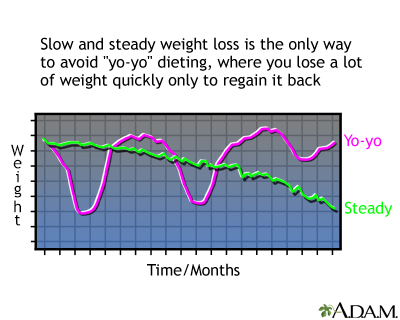
|
Review Date:
12/16/2012 Reviewed By: Robert A. Cowles, MD, Associate Professor of Surgery, Yale University School of Medicine, New Haven, CT. Review provided by VeriMed Healthcare Network. |

